A sordid tale, starting in the bedroom, involving batteries, deceit, cheap tricks, LEDs, and a pot.
It started innocently enough. A family member hinted that a good way to keep warm on cold winter nights was with a heated mattress pad– more sensible than heating the whole house.
Winter came, it got cold, and we got our mattress pad.
The heated pad has a simple digital controller, where you rotate the dial to set the temperature, on a scale of 1-10, or really, L-2-3-4-5-6-7-8-9-H. So far, so good. (And it’s comfy warm, too.)
But, then we took a closer look at that LED display:
What seems to be a digital seven-segment LED display is actually a rear-lit cutout in the shape of a seven-segment display, with one cutout in the shape of each number. The rotating dial just masks the other shapes so that you only see one at a time.
In other words, it’s about as digital as blip.
The whole bezel is rear lit by an LED driven directly off of the AC– you can tell from the blinking. (Driving LEDs from line voltage is common in consumer electronics; it works reasonably well if you have a big series resistor.)
Somewhere around this point we went from saying “WTF?” to “What the heck!” — because it’s a clever cheap trick, and if they can do it, so can we.
Sure, we can imagine a few cases where something like this could be genuinely useful, either as a front panel indicator or perhaps as a stage prop. But mainly we just wanted to make our own it because it’s hilarious.
We’ll scale our dial to turn a standard 5 k pot, so that our fake digital display can do something useful.
Next, to design the bezel:
We laser cut the parts– black and clear plastic for the number plate and plywood for the dial/knob. The black plate fits over the threads of the pot, and the big wooden knob press fits onto the shaft of the pot; the pot turns when you turn this dial, revealing a single number beneath.
You can download our pattern here (8 kB PDF document).
It’s pretty simple, but if you want to play with the mechanism, you can print out both parts, grab a pair of scissors and a brass brad, and assemble it like we did in this project.
Next, we need the LEDs. For maximum fancy (without using actual seven segments!) we got out the fat LEDs:
Two LEDs each, blue, green, yellow, orange, and red, to backlight the positions between L and H. We powered it from a 3xAAA battery box, and hooked it up on a breadboard to figure out the right resistor values to drive the LEDs efficiently. (Also, looks neat in the dark.) The four blue and green LEDs are independently driven off of the 4.5 V with their own series resistors. The two red LEDs are driven in series with a resistor, and that setup is used for the yellow and orange LEDs as well.
Then, we wire up the LEDs in a circle, using the same circuit:
And then we can install the black and clear number plate:
And there you have it: A five-color LED-lit fake-seven-segment pseudo-digital pot, based on advanced mattress pad technology.







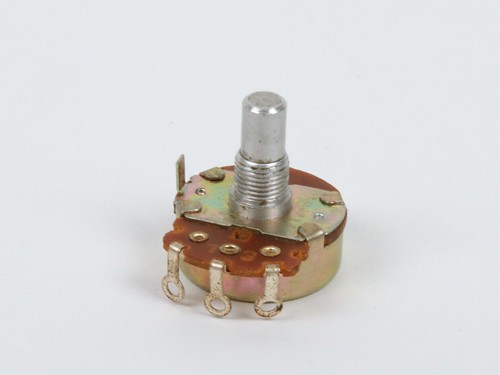

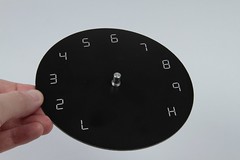
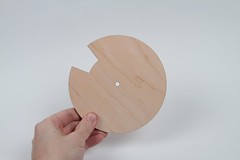
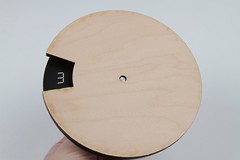

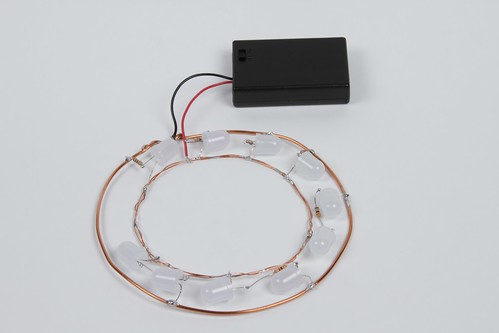


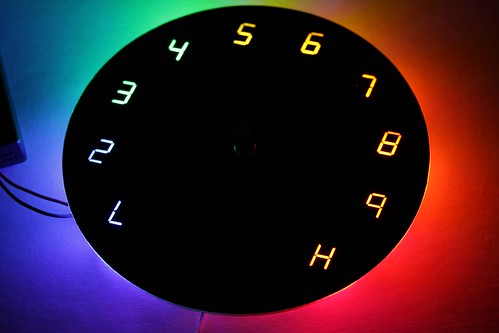
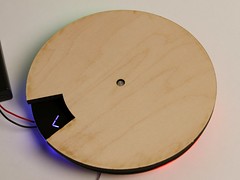
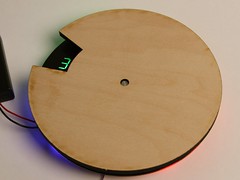

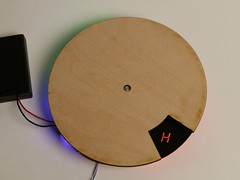
My toaster has a similar method for the lightness/darkness selector, just the wheel with the numbers rotates in front of the light instead
I wonder why they bothered with the 7 seg font.
Why, to make it look "digital" of course. Believe it or not, that will get someone in the store to buy that one over another brand.
After all humans still think digital watches are pretty neat.
Very neat indeed, Mr. Adams!
I think he said: "ape-descended life-forms (who) are so amazingly primitive that they still thing digital watches are a pretty neat idea."
You mean, he was talking about humans? Ohhhhhhhh…
That’s what I’m wondering. With that sort of setup, they could have made it anything! Barcharts, piecharts, roman numerals, pictographs, calligraphy, standard intergalactic alphabet… Anything but a seven segment display. It would be an interesting way of setting your product apart from all the other seven-segment-display-pads, and even making it look classier.
So I could therefore replace the cutout within the control unit for the mattress pad and make a duplicate? Instead of digital numbers I could use smiley faces indicating the level of heat? I could change the LED bulb color for a color more to my preference? That would be quite fun.
Yes, but please exercise care with the line voltage. :)
Windell H. Oskay
drwho(at)evilmadscientist.com
http://www.evilmadscientist.com/
You don’t want to be running a mattress pad when you’re in bed. (Likewise, electric blankets.) Electric blankets expose you to prodigious levels of time-varying electromagnetic fields, inducing currents in your body that have effects that are little-understood. Duty-cycle switched (e.g. this one) are worst. Healing processes (which mostly happen when you’re asleep) are guided by sub-nanoamp currents in that can be swamped by those induced by the blankets. For interesting details, see The Body Electric (1973) by Robert Becker and Gary Selden.
Use the mattress pad to warm up the bed, and then turn it off before you get in.
If you drive the heating element with well-filtered DC current, it’s OK; DC fields don’t induce currents in your body. People here are equipped to do that sort of thing. I gather you can buy DC pads, but I haven’t looked for them. I would expect them to cost more.
What, don’t you wear a tinfoil night cap that protects you at night?
Faking a seven-segment display is one thing. Faking medical research in the name of selling books is another.
If you want to bring up or defend speculative pseudoscience and quackery, you are welcome to do so– but elsewhere please. Our blog is not a welcome soapbox for you.
Windell H. Oskay
drwho(at)evilmadscientist.com
http://www.evilmadscientist.com/
And this is why we all love Windell.
Thank you for slapping down the woo merchant.
Becker’s research was not what anyone scrupulous would call fake. A great deal of it was published in peer-reviewed journals, funded chiefly by the U.S. Veteran’s Administration, which had an interest in research on regeneration. The topic remains unfashionable, yet, electromagnetic cuffs to accelerate fracture healing are in mainstream usage by veterinarians.
Sometimes it’s hard to separate a set of people with bizarre beliefs from the people that inspired those beliefs. It’s not clear exactly where to draw the line, but there’s obviously a lot of nonsense out there and I’m not interested in debating it.
(For further reading, see here.)
> Becker’s research was not what anyone scrupulous would call fake.
Perhaps some of it is merely wrong. However to wholeheartedly endorse it all as “valid” would be a very irresponsible claim. Legitimizing this– in other words, to say that it’s okay to divert funding from life-saving research in order to work on understanding how electromagnetic fields cause AIDS (or the other claims)– is simply not conscionable.
> A great deal of it was published in peer-reviewed journals
This argument isn’t very relevant.
Peer review generally ensures that no obvious, gross violations of protocol occurred. It does not guarantee that research is correct.
In the case of general-audience science books, there’s always going to be a lot of narrative and speculation that wouldn’t have a place in peer review.
>[…]funded chiefly by the U.S. Veteran’s Administration […]
The US military and associated programs also fund research into “remote viewing,” faster-than-light travel, and flying saucers. I don’t think that a funding source legitimizes research nor its outcome.
>The topic remains unfashionable, yet, electromagnetic cuffs to accelerate
>fracture healing are in mainstream usage by veterinarians.
Acupuncture, dowsing, homeopathy and astrology are used by millions, too.
From what I can tell, EM pulse therapy for treating fractures is considered questionable; modern clinical studies have not shown a significant effect beyond a reasonable doubt.
Windell H. Oskay
drwho(at)evilmadscientist.com
http://www.evilmadscientist.com/
Actually, some (mostly anecdotal) evidence has shown that poorly-controlled low-frequency RF can cause health issues. However, the problems are mostly headaches/nausea (occasionally night terrors) and mostly in people that are sensitive to them. They can be negated, however, by proper wiring and engineering practices. Your biggest worry from using a mattress pad is faulty wiring causing shock, fire, or burns.
Tell you what. How about making this topic the next post. I’m sure the people who posted about this can test this easily with an osciliscope. I’m also interested in learning about the frequencies of electromagneic radiation that escape a microwave, one of which is not the resonant frequency of water. Before you say nothing could escape, please look up emmision spectrums and absorbancy spectrums. Such as that of hydrogen, for example. That will show the frequencies that a substance can emit or absorb.
I hate to be all pedantic and crap, but if it is displaying a numeral to represent any particular heat level, then it is, in fact, a "digital" display.
Also, you turn it with your fingers. :P
More seriously, we usually mean "discrete" and "continuous" when we say "digital" or "analog."
If the dial actually adjusts an analog signal– like our pot does –then the variable controlled is a continuous one– and is not restricted to the digits that are displayed.
Windell H. Oskay
drwho(at)evilmadscientist.com
http://www.evilmadscientist.com/
You could always use a rotary switch instead of the pot to make it more ‘digital’.
Why, you could make a dial that goes to eleven!
(Sorry for posting this elsewhere, between yahoo account and this my brain got confused.)
This reminds me of various art works with several layers of apparently random shadow masks, The angle of light entering resolves into coherent shadows as different portions of the masks align. I remember seeing one that was essentially a digital (using the term loosely) sundial. As the sun moved through the sky the shadow on the ground would morph through the hour digit of the correct time. Another would morph from one line of a poem to another as the sun arcs across the sky.
You could have made it go to 11; it would be one warmer than any other band’s mattress pad.
Super-looking project! Now then – how’s it made?
Alas, so typical of anything posted recently – Step 1 – Simply laser-cut/3d print the following parts …
Gah!
<navigates away to red tube>
(Yes yes yes I know we’re ingenious makery types gifted with the wherewithal to take an idea and make it our own using only the two lolly sticks and some goop scraped from under the cooker-hood, but really. The desktop fab revolution isn’t quite here for all of us yet.)
:)
We laid out two ways to do this– one that requires fancy tools from this generation, and one that requires only fancy tools from last generation.
If you use the latter method– print out the pattern and cut it out with scissors, and add the brass brad like we suggest, you can do this at home in about five minutes. It’ll look like the inch-adder that we linked to. Please understand that when we show off one of the methods, it’ll sometimes be the one that makes for prettier pictures.
Also, and importantly: YOU CAN get stuff laser cut. It’s not like we’re teasing you with secret ingredients. Laser cutting these days is basically a matter of taking our PDF file and sending it– along with a credit card number — to any number of different companies that do this now (Pololu, Ponoko, and on and on). It’ll take five minutes to set up, 20 bucks, and a few days to wait for it.
No biggie, m’kay?
Windell H. Oskay
drwho(at)evilmadscientist.com
http://www.evilmadscientist.com/
And if that is still to pricey for what you have in mind you can always make your own pdf and print a transparency. You can easily use custom fonts or pictures instead. $14 will get you 100 sheets.
[link:http://www.amazon.com/3M-HIGHLAND901-8-5inx11in-Transparency-Film/dp/B00006HOY8]
And if you are feeling really artsy you can paint on them with water colors.
Doesn’t anyone realize this could be modified to be an Iron Man chest piece?
(Well, okay, only Tony Stark at least.)
If nixie tubes were not so damned expensive, I would be so into nixie tubing everything (starting with heated mattresses). I once found a tutorial on how to build a nixie tube clock, but prices at ebay cured me… *sigh*
Windell, you are awesome. Keep up the good work.
But why did you not just power your new LEDs with AC? I was expecting a dropin replacement for pad’s display!! :-D
>But why did you not just power your new LEDs with AC?
Encouraging people to play with mains power is usually ill-advised.
>I was expecting a dropin replacement for pad’s display!! :-D
Our huge version? That’s kind of funny, I suppose. I imagine this sort of thing being used as a prop in a school play. :P
Windell H. Oskay
drwho(at)evilmadscientist.com
http://www.evilmadscientist.com/